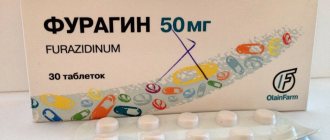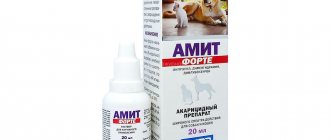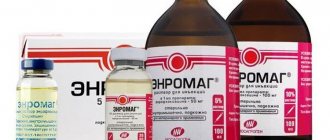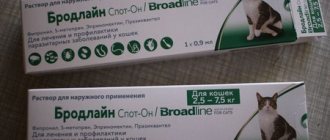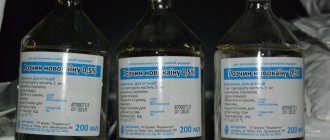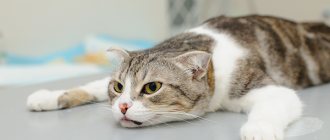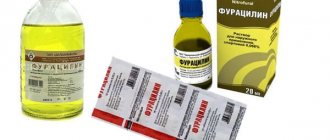Basic information about the use of the drug in cats and other species of animals
According to the instructions for use of the drug, azithromycin is a new generation azalide or macrolide antibiotic
. Macrolide antibiotics act by inhibiting protein synthesis in susceptible bacteria and are generally considered bacteriostatic. New generation macrolides are characterized by high concentrations in tissues and relatively lower concentrations of the antibiotic in blood serum.
Azithromycin is concentrated in polymorphonuclear leukocytes, which gravitate to the site of infection and inflammation during chemotaxis. Phagocytosis by polymorphonuclear leukocytes exposes intracellular pathogens to very high, potentially lethal concentrations of antibiotics. In particular, azithromycin has an increased half-life from tissues. Long-term high concentrations of azithromycin at the site of infection and inflammation allow once-daily dosing and may shorten the duration of treatment.
Possible restrictions
Having a strong antibacterial effect, Azithromycin can also cause harm. And the medicine is especially dangerous for cats that have been diagnosed with chronic liver pathologies, kidney disorders and hypersensitivity to any component of the antibiotic. Pregnant and lactating purrs should be given Azithromycin especially carefully, strictly adhering to the doses prescribed by the veterinarian. And most often during this period of a cat’s life, the dosage is 1.5-2 times less than usual.
Treatment of cats with the antibiotic Azithromycin
According to the instructions for use, azithromycin has been used successfully in dogs to treat Babesia Gibsoni
(Asian genotype). Babesia is a hemotropic protozoan parasite transmitted by ticks. When treating Babesia Gibsoni, azithromycin is usually combined with atovaquone. Azithromycin, in combination with other drugs, has been proposed for the treatment of systemic nontuberculous mycobacterial disease in cats. M. avium and M. fortuitum are the most common causes of systemic mycobacterial infection in pets.
These infections are often resistant to traditional anti-TB drugs such as isoniazid and ethambutol. Systemic M. avium infection is particularly difficult to treat and has a poor prognosis. Basset hound dogs and Siamese cats may have an increased susceptibility to these infections.
Antibiotic analogues
Russian studies prove the high effectiveness of Sumamed (azithromycin) compared to many other antibiotics.
But still, we can give several examples of acceptable antibiotics for animal options:
Erythromycin. The cost of this drug is lower than Sumamed, however, the effectiveness is several times lower. It is used for infections of the upper and lower respiratory tract, purulent-inflammatory diseases of the skin and its appendages. There are a number of contraindications compared to azithromycin. Erythromycin is not recommended for pregnant, lactating dogs and puppies up to six months old.
Midecamycin. Used for infections of the respiratory tract and genitourinary system caused by intracellular microorganisms. There are contraindications: hypersensitivity, severe liver failure. Unlike Sumamed, it is not recommended for pregnant and lactating dogs.
Sinulox. An antibiotic of the penicillin group, which contains amoxicillin and clavulanic acid. This remedy has a wide spectrum of action and is prescribed for the treatment of: infectious diseases of the stomach and intestines, inflammatory processes localized in the genitourinary system, etc. In terms of effectiveness, it is inferior to Sumamed.
Learn about essential antimicrobials in animals
- Trichopolum for animals
- Instructions for the use of baytril in veterinary medicine
- Metronid for animals
- Instructions for the use of ceftriaxone in veterinary medicine (Ceftriaxone)
- Antibacterial effect of metrogil in animals
- Instructions for the use of doxycycline in animals
- Metronidazole for animals (instructions for use in veterinary medicine)
- Atovaquone (ATOVAQUONE)
Azithromycin is used to treat bartonellosis in cats. Bartonella is a Gram-negative hemotropic bacterial organism found primarily in red blood cells and endothelial cells. This is a zoonotic disease. A similar infection in humans is commonly called cat scratch disease.
Bartonella is transmitted between cats primarily through fleas, although most naturally infected cats do not develop clinical disease. Bartonella, which causes conjunctivitis, is well known in humans, and some veterinary ophthalmologists are beginning to recognize and treat ocular strains of Bartonella in cats. The diagnosis of feline bartonellosis is complex, and optimal antimicrobial protocols for clinical feline bartonellosis are the source of much controversy.
In 2006, the American Association of Feline Practitioners group published a comprehensive report on the diagnosis, treatment, and prevention of Bartonella spp. infections in cats. Doxycycline appears to be their first choice antibiotic, with azithromycin or fluoroquinolone used in cases that do not respond to doxycycline. Because Bartonella is a zoonosis, special care should be taken to avoid bites or scratches when administering antibiotic therapy.
Indications for use
Many diseases can be successfully treated only with the use of antibacterial drugs. So, antibiotics for cats are usually prescribed to treat the following diseases:
- tuberculosis;
- giardiasis;
- pneumonia;
- pyelonephritis;
- cystitis and urethritis;
- feline herpes;
- various ear and eye infections;
- bacterial gastritis;
- purulent and bacterial lesions of the skin;
- intestinal infections;
- leptospirosis;
- rhinitis (upper respiratory tract infections);
- pyometra (inflammation in the uterus due to infection);
- urolithiasis disease.
Antibiotics must be prescribed after surgery (including after sterilization). They are also given to cats suffering from cancer, because antibacterial drugs prevent the spread of infection to the affected organs and tissues.
Use of azithromycin in horses
According to the label, azithromycin is used in foals to treat Rhodococcus equi infection
. Can be used alone or in combination with the antibiotic rifampicin. R.equi pneumonia is the most severe bacterial pneumonia in foals. Other sites of R. equi infection include the gastrointestinal tract and joints. All forms of R.equi infection are very difficult to diagnose, and abscess formation due to R.equi makes these infections difficult to treat. Deaths can occur even with timely diagnosis and treatment.
For many years, erythromycin or erythromycin plus rifampin has been the standard treatment for R. equi infections in horses. Recently, macrolides have gained popularity. These are newer generation antibiotics, azithromycin and clarithromycin. According to the instructions for use, azithromycin has better absorption characteristics than erythromycin.
The terminal half-life of azithromycin in serum, in bronchial alveolar lavage cells and in epithelial cells of the mucous membranes of the respiratory tract is significantly longer than that of erythromycin or clarithromycin. The peak activity of the drug in the cells of bronchial alveolar lavage is the same for both azithromycin and clarithromycin, and is significantly higher than that of erythromycin. Recent studies at the University of Texas examined the prophylactic use of azithromycin in foals on endemic R. equi farms.
Side effects
When the antibiotic is used correctly, treatment proceeds well and shows excellent results. But if you neglect the veterinarian’s recommendations or treat your pet without permission, then the following undesirable effects may develop while taking Azithromycin:
- nausea;
- urge to vomit;
- general weakness;
- drowsiness;
- nervous system disorders;
- excitement.
If any side symptom appears, it is necessary to stop the therapy and take the pet to the veterinary clinic.
Azithromycin maleate has some side effects
No information was found in the literature on the side effects of the combination of atovaquone and azithromycin in animals.
Malarone (atovaquone) in combination with proguanil hydrochloride should not be used in dogs due to the high incidence of gastrointestinal side effects.
In humans, the most common side effects of the drug combination atovaquone and azithromycin were diarrhea and rash, and the most common side effects of malarone were gastrointestinal. These included abdominal pain, nausea, vomiting, anorexia and diarrhea.
How is the virus transmitted and is rhinotracheitis dangerous for people?
A cat can become ill with infectious rhinotracheitis even without leaving home; in some cases, the animal becomes infected after contact with the owner’s street clothes or shoes. Herpes has a stable structure, which leaves a risk of transmitting the disease to your pet after contact with a sick animal outside the home.
The disease is transmitted from infected cats primarily through airborne droplets. Main routes of infection:
- direct contact with a carrier of the virus;
- food from shared dishes with a sick animal;
- common seating areas;
- using an infected cat's litter box for a healthy cat;
- general toys;
- mating with a sick cat;
- from mother to kittens during pregnancy or nursing;
- walking an animal on the street or participating in exhibitions.
A cat with rhinotracheitis remains contagious even after recovery. The virus contained in biological secretions (urine, saliva, milk) will be enough to infect healthy pets, especially those with weakened immune systems, for example during pregnancy or after sterilization.
In kittens and young cats, rhinotracheitis occurs most often due to the fact that an insufficiently developed immune system cannot fight the aggressive disease.
In some cases, rhinotracheitis becomes chronic, causing complications such as: pneumonia, gastrointestinal problems, central nervous system damage, and regular relapses of rhinotracheitis.
The feline herpes virus is not dangerous to humans, but a weakened person should be careful in contact with a sick pet.
Precautionary measures
According to the instructions, the most common side effects in all types of animals are from the gastrointestinal tract. Vomiting due to azithromycin preparations can occur in dogs and cats. Foals may experience mild to moderate diarrhea. Hyperthermia is a serious and potentially fatal side effect that can be seen in foals. There is ample clinical evidence that foals on erythromycin are very sensitive to heat stroke and possibly to bright sunlight, and similar hyperthermia has been reported in isolated cases with both azithromycin and clarithromycin. Because of this problem, many veterinarians do not give macrolide antibiotics to foals during the day. If hyperthermia occurs, aggressive cooling using water and fans or air conditioning is helpful.
Instructions for use
In the process of scientific research conducted under the guidance of Doctor of Veterinary Sciences Litvinenko Yu. V., it was possible to establish effective dosages of the antibacterial drug Azithromycin for cats of various body weights. Thus, the dosage is calculated as follows: per 1 kg of pet’s weight, 5-15 mg of medication is required, depending on the diagnosis and the well-being of the sick pet. Frequency of administration - no more than 2 times, always at equal intervals, which is 12 hours. The duration of the treatment course is 5 days, but at the discretion of the veterinarian, the period for the cat to receive Azithromycin can be extended to 1-2 weeks.
Drug interactions
According to the instructions, azithromycin should not be used in animals taking cisapride.
Azithromycin can be combined with rifampicin. Oral antacids may reduce the rate of absorption of azithromycin. Overdose of any macrolide antibiotic can cause serious gastrointestinal side effects. Some veterinarians use oral probiotics in foals treated with macrolide antibiotics to reduce the incidence or severity of antibiotic-induced diarrhea.
